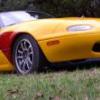Note the last paragraph.
http://mazdamotorspo...v&uniqueId=1672
Apologies for the ditty going through your head right now after reading the title, whether it may be Queen or Billy Joel, but have you considered your tire pressure lately?
That seems like a stupid question … of course you have. Tire pressure is on the list that every racer thinks about. You probably know what it is at the beginning and end of each session, and maintain a log of starting pressures for each track and/or surface you race on. But there are a few things about tires pressure that you may not have considered.
Ken Payne, Motorsports Technical Director for BFGoodrich Tires, gets many questions about pressure. Often those questions are related to temperature and pressure fluctuations.
“A 10-degree temperature change is roughly three-quarters of a psi equivalent in pressure,†explains Payne. “With TPMS-equipped vehicles, if you’re not regularly checking your pressures, you may find you get a pressure alarm when the first good cold blast comes in the winter, because of that natural temperature-pressure relationship.â€
And that’s why you keep, and Payne encourages racers to keep, records of tire pressures.
“When you go to a track, record ambient temperature, record the starting cold pressure when you went out on track and record the hot pressure. Keep a record of what the pressure delta is between cold and hot. It’s really helpful information to use as a starting point when you go back to another track. As you build your record book, you’ll find cold weather, medium and hot weather data you can use to help figure out where you want to be when you go to a different track in different conditions,†he says.
The thing on most racers’ minds when thinking about tire pressures is contact patch, and keeping the most of it on the track as much as possible. But contact patch isn’t the only thing that pressure affects. The tire affects the car’s spring rate as well.
“Aside from having to provide braking force and acceleration force, it is effectively a suspension component. It has an inherent spring rate, both vertically and laterally. For subtle tuning of the vehicle, depending on the wheel size, the rest of the setup on the car and the sensitivity of the car itself, the impact may vary. If you increase the air pressure, that’s going to effectively, slightly, increase the spring rate of the tire. Those tuning effects are no different than if you’re going up in spring rates or up in swaybar stiffness in front and rear. It’s another subtle tuning tool you have at your disposal,†says Payne.
Now, of course, comes the issue of measuring pressure. Every racer has a pressure gauge, and probably a very good, expensive one. But like many other tools, they’re not always treated with the utmost respect. While it’s easy to think that ultimate accuracy doesn’t matter – as long as it can discern differences in psi – that isn’t necessarily true. And what happens if yours is way off and you borrow someone else’s? Tool accuracy is important.
“At some of our events that our BFGoodrich support track is at, whether it’s an SCCA Super Tour or MX-5 Cup, we often have a pressure gauge calibration stand,†Payne says. “I encourage racers to check their pressure gauges for accuracy. It’s not uncommon to find pressure gauges that are a couple, 3, 4 or 5 psi off. If you don’t have the luxury of a calibration stand, with some of your buddies that you’re at the track with, do back-to-back comparison with other gauges with different tires and other pressures to see if you essentially come up with the same readings. It’s a ballpark check to at least know if yours is completely different.â€




 Sign In
Sign In Create Account
Create Account












 Back to top
Back to top Report
Report











